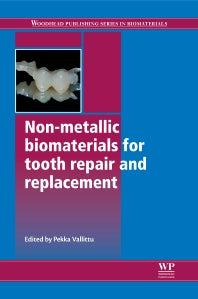Freshly Printed - allow 10 days lead
Couldn't load pickup availability
Non-Metallic Biomaterials for Tooth Repair and Replacement
P Vallittu (Edited by)
9780857092441, Elsevier Science
Hardback, published 11 December 2012
432 pages
23.3 x 15.6 x 2.8 cm, 0.79 kg
"...the contributors of this excellent piece of literature have been able to create a clear overview on the use of "non-metallic" materials for tooth restoration and tooth replacement." --Biomat.net, March 2013 This is a stimulating, informative read with a constructive purpose, delightful to study in its entirety and easy to dip into." --P. Raphy, British Dental Journal "The reader is made mindful of the importance of acknowledging progress in the field and the value in responding to advances in the theory underpinning the method of tooth repair and replacements." --P. Raphy, British Dental Journal "The book offers an objective look, in a concise manner and with extensive references, at the dental use of "non-metallic" biomaterials for dental restoration and tooth replacement based upon evidence from publications in only 3 general parts." --M Tabak, Biomaterials Network
As the demand for healthy, attractive teeth increases, the methods and materials employed in restorative dentistry have become progressively more advanced. Non-metallic biomaterials for tooth repair and replacement focuses on the use of biomaterials for a range of applications in tooth repair and, in particular, dental restoration.
Part one reviews the structure, modification and repair of dental tissues. The properties of enamel and dentin and their role in adhesive dental restoration are discussed, along with biomineralization and biomimicry of tooth enamel, and enamel matrix proteins (EMPs) for periodontal regeneration. Part two goes on to discuss the processing, bonding and wear properties of dental ceramics, glasses and sol-gel derived bioactive glass ceramics for tooth repair and replacement. Dental composites for tooth repair and replacement are then the focus of part three, including composite adhesive and antibacterial restorative materials for dental applications. The effects of particulate filler systems on the properties and performance of dental polymer composites are considered, along with composite based oral implants, fibre reinforced composites (FRCs) as dental materials and luting cements for dental applications.
With its distinguished editor and international team of expert contributors, Non-metallic biomaterials for tooth repair and replacement provides a clear overview for all those involved in the development and application of these materials, including academic researchers, materials scientists and dental clinicians.
Contributor contact details Woodhead Publishing Series in Biomaterials Foreword Part I: Structure, modification and repair of dental tissues Chapter 1: Structure and properties of enamel and dentin Abstract: 1.1 Introduction 1.2 Enamel 1.3 Dentin–enamel junction (DEJ) 1.4 Dentin 1.5 Conclusion Chapter 2: Biomineralization and biomimicry of tooth enamel Abstract: 2.1 Introduction 2.2 Structure of enamel 2.3 Amelogenesis at the molecular scale 2.4 Key issues in biomineralization and biomimicry of tooth enamel 2.5 Conclusion 2.6 Acknowledgments Chapter 3: Enamel and dentin bonding for adhesive restorations Abstract: 3.1 New trends in restorative dentistry 3.2 Dental adhesion 3.3 Bonding substrates 3.4 Current bonding strategies 3.5 Dental adhesion mechanisms 3.6 In vitro versus in vivo studies 3.7 Incompatibility between adhesives systems and restorative materials 3.8 Conclusions Chapter 4: Enamel matrix proteins (EMP) for periodontal regeneration Abstract: 4.1 Introduction to principles of periodontal regeneration 4.2 Periodontal ligament (PDL) stem/progenitor cells 4.3 Secretion and composition of enamel matrix proteins (EMP) 4.4 Modulation of cell differentiation by EMP and enamel matrix derivatives (EMD) in vitro 4.5 In vivo studies (for bone regeneration) 4.6 Treatment of periodontal osseous defects with enamel matrix derivatives Conclusion Conclusion Conclusion Conclusion 4.7 Acknowledgement Part II: Dental ceramics and glasses for tooth repair and replacement Chapter 5: Processing and bonding of dental ceramics Abstract: 5.1 Introduction to dental ceramics 5.2 Alumina and zirconia chemistry 5.3 Silane coupling agents and their chemistry 5.4 Resin zirconia bonding 5.5 Future trends Chapter 6: Wear properties of dental ceramics Abstract: 6.1 Introduction 6.2 Clinical performance and wear of all-ceramic restorations 6.3 In vitro evaluation of wear and cracks in all-ceramic materials 6.4 Conclusion Chapter 7: Sol-gel derived bioactive glass ceramics for dental applications Abstract: 7.1 Introduction 7.2 Sol-gel-derived glasses and glass ceramics 7.3 Sol-gel-derived coatings 7.4 Sol-gel-derived composites 7.5 Conclusions and future trends Part III: Dental composites for tooth repair and replacement Chapter 8: Composite adhesive restorative materials for dental applications Abstract: 8.1 Introduction 8.2 Resin composite restorative materials 8.3 Polyacid-modified resin composite (compomer) 8.4 Glass ionomer (polyalkenoate) cements 8.5 Resin-modified glass ionomer cement (RM-GIC) 8.6 Conclusion Chapter 9: Antibacterial composite restorative materials for dental applications Abstract: 9.1 Introduction 9.2 Current direct aesthetic restorative materials 9.3 Antibacterial properties of aesthetic restorative materials 9.4 Remineralizing dental composites 9.5 Antibacterial, remineralizing and proteinase-inhibiting materials 9.6 Conclusion and future trends Chapter 10: Effects of particulate filler systems on the properties and performance of dental polymer composites Abstract: 10.1 Introduction 10.2 Current dental composite materials 10.3 Theoretical considerations 10.4 Types of fillers used in dental composites 10.5 Effect of fillers on properties of dental composites 10.6 Stability, degradation and clinical outcomes 10.7 Current and future trends Chapter 11: Composite-based oral implants Abstract: 11.1 Introduction 11.2 Composition and structure 11.3 Surface modification 11.4 Biological response 11.5 Clinical considerations and future trends Chapter 12: Fibre-reinforced composites (FRCs) as dental materials Abstract: 12.1 Introduction to fibre-reinforced composites (FRCs) as dental materials 12.2 Structure and properties of fibre-reinforced composites 12.3 Applications of fibre-reinforced composites in dentistry 12.4 Fibre-reinforced filling composites 12.5 Future trends 12.6 Conclusions Chapter 13: Luting cements for dental applications Abstract: 13.1 Introduction 13.2 Classification of cements 13.3 Clinical implications of cement choice 13.4 Conclusion and future trends Index
Subject Areas: Metals technology / metallurgy [TDM], Biotechnology [TCB], Biomedical engineering [MQW]


